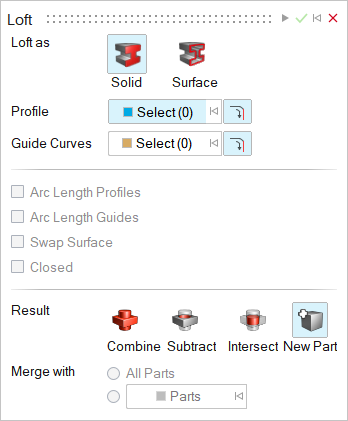Loft
Create a solid loft or a lofted surface from profiles and guide curves. Create a new part from the loft or combine, subtract, or intersect the loft with existing parts.
First, create the profiles and guide curves that you'd like loft.
-
On the Geometry ribbon, select the Loft tool.

Note: The tool may be hidden in a dropdown menu. To access the dropdown menu, you can do one of the following:- Click and hold the currently displayed tool (Sweep, Multi Sweep, or Pipe).
- Select
 at the lower right corner of the
currently displayed tool (Sweep, Multi Sweep, or Pipe).
at the lower right corner of the
currently displayed tool (Sweep, Multi Sweep, or Pipe).
The guide panel appears.
-
Choose the entity type that you'd like to create:
- Solids: Loft as a solid.
- Surfaces: Loft as a surface.
-
Select a Profile. By default,
Select is automatically turned on. (Optional): Select
 Tangent Propagation so that clicking an edge will also
select all of its tangent edges.
Note: To deselect, hold down Ctrl while clicking. To clear all selected features, click
Tangent Propagation so that clicking an edge will also
select all of its tangent edges.
Note: To deselect, hold down Ctrl while clicking. To clear all selected features, click next to the Select button in the guide
panel.
next to the Select button in the guide
panel. -
Choose Guide Curves:
- Click the Select button.
-
Select a sketch or an edge. The plane in which the profile lies must
intersect the guide curve.
Note: To deselect, hold down Ctrl while clicking. To clear all selected features, click
 next to the
Select button in the guide
panel.
next to the
Select button in the guide
panel. -
(Optional): Select
 Tangent Propagation so that clicking an edge will
also select all of its tangent edges.
Tangent Propagation so that clicking an edge will
also select all of its tangent edges.
-
Edit the loft:
To Do this Notes Reselect profiles or rails - In the guide panel, click the Select button next to Profiles or Guide Curves.
- Select the profiles or rails you want to add or remove.
Define other options In the guide panel, select from the following options: - Arc Length Profiles: Evenly space the isoparms in the direction of the profiles.
- Arc Length Guides: Evenly space the isoparms in the direction of the guide curves.
- Swap Surface: Quickly interchange the profiles and guide curves to get a preferred shape.
- Closed: Close the loft.
Invert the direction of a profile or guide curve - Select the vertex of the profile or the guide curve.
- In the microdialog, turn on Invert Direction
The direction of the arrow on the profile or guide curve indicates its orientation.
In most cases, the optimal orientation of each profile is internally calculated so that the resulting surface is not twisted. In some cases, inverting a profile's direction will cause the loft to fail. Apply a constraint to a selected profile - Select the vertex on the profile.
- In the microdialog, for Constraints, choose one of
the following:
- Position (G0): No constraints are set; the loft surface is connected to the surface edge, but not tangent to it
- Tangent (G1): The loft surface is made tangent to the surface edge but does not follow the curvature of the adjacent surface.
- Curvature (G2): The loft surface is made tangent to the surface edge and follows the curvature of the adjacent surface.
- Normal: The loft surface is made perpendicular to all vertices. This option is useful for planar curves.
To invert the direction of the profile's tangent, in the microdialog click Invert Tangent  .
.Modify the tangent magnitude of a selected profile - Select the vertex on the profile.
- In the microdialog, enter a Magnitude.
-
Choose a Result type:
- Combine (only available for Solids): Combine the loft with the existing parts.
- Merge (only available for surfaces): Merge the lofted surface with existing parts
- Subtract (only available for Solids): Carve out the loft from the existing parts.
- Intersect (only available for Solids): Retain only the intersecting portions of the loft and the existing parts.
- New Part: Create a new part from the loft.
-
If you selected Solids, choose a
Merge method:
- All Parts (default): Merge the loft with all parts that touch it.
- Parts: Select the radio button to merge the loft with selected parts. Then select the parts that you’d like to merge the loft with.
- Click Apply.
- Right-click and mouse through the check mark to exit, or double-right-click.